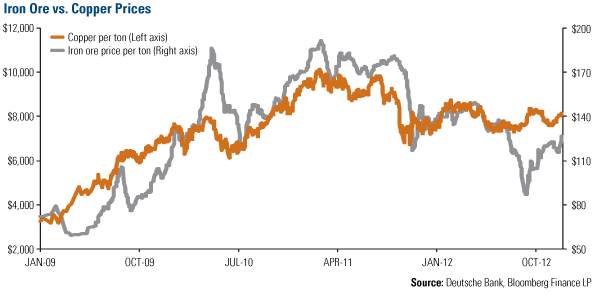Energy and Natural Resources Market Radar (December 17, 2012)

Strengths
- Crude oil futures closed the week up 1 percent from last Friday after the Federal Reserve announced a fresh round of monetary stimulus and the International Energy Agency revised its 2013 global oil demand forecast upward to 90.5 million barrels per day.
- VLCC crude oil tanker rates on the benchmark Arabian Gulf to Far East route have risen briskly this week. On a day-rate basis, this equates to a current time charter equivalent (TCE) of about $21,000 per day, up from $5,000 per day last week. While this is a dramatic rise in a short time, we note this is still just barely above cash flow breakeven costs for most owners.
- Farmland values in Iowa, the biggest U.S. grower of corn and soybeans, surged 24 percent to the highest ever in 2012, according to an Iowa State University survey of real-estate transactions. The value of agricultural land rose to an average of $8,296 an acre in the year ended November 1, up from a previous all-time high of $6,708 in 2011, reported the university in Ames, Iowa. This is the third-consecutive year that values have increased more than 15 percent, and this is the first time county averages have reached levels over $10,000, survey results showed.
Weaknesses
- Natural gas futures have dropped 15 percent since hitting a recent high of $3.901 on November 23 as mild winter weather has weakened demand.
- In a press release following the conclusion of its December 12 meeting, OPEC announced that it will keep production targets unchanged at 30 million barrels per day. The communiqué noted that worries over the global economy persist, and world oil demand growth is likely to be more than offset by non-OPEC supply, saying that the demand for OPEC crude would fall to 29.7 million barrels per day in 2013.
- Wheat declined 5 percent this week to the lowest level in five months on concern that India, the world’s second-largest grower, may ship more of the grain from government stockpiles, intensifying competition among exporters.
Opportunities
- The Fed announced a fresh round of monetary stimulus. As expected, the Federal Open Market Committee (FOMC) replaced “operation twist” with $45 billion of nominal Treasury purchases with “an average duration of approximately 9 years.” In a note published this week, Deutsche Bank economists expect this open-ended QE to last through the third quarter of 2013. In an unprecedented move, the Fed indicated that interest rates would remain near zero until the unemployment rate drops to at least 6.5 percent and as long as it does not forecast inflation above 2.5 percent. This is seen as positive for equities, negative for the dollar and consequently constructive for commodities.
- A steep decline in steel inventories may lead to stronger-than-usual restocking in the New Year, says Reuters. Data suggest that inventories in some Chinese cities have fallen by up to half as traders avoided restocking due to weak demand during the year.
Threats
- Quebec Premier Pauline Marois said her government will meet mining companies in the next three months to gather input as it seeks to raise royalty taxes on mining companies to help generate revenue. “We will have a discussion probably in February or March” with mining companies, Marois said in an interview at Bloomberg’s headquarters in New York. “We want to raise more revenues from royalties, but we don’t want to kill the industry,” she added.
- Fitch said that Western European steel output is unlikely to recover in 2013 due to depressed demand levels across the eurozone. Steel volumes will probably fall by up to 3 percent, Fitch Ratings believes, putting pressure on producers' profitability and free cash flow generation. However, profit margins may be supported by the falling cost of raw materials. Construction activity is the weakest area while demand from automotive manufacturers and mechanical engineering may increase towards the end of 2013. This lackluster demand means prices are likely to remain flat through the year.
- Australian high-quality hard coking coal prices may drop by 19 percent to average $171 per ton free on board in 2013 compared to $210 per ton this year, Platts reported citing a report by Australia’s Bureau of Resources & Energy Economics. The price-drop forecast comes as supply increases to outpace the outlook for steel production growth led by China, India and other emerging markets, the agency said.












